#mémoires collectives
Text

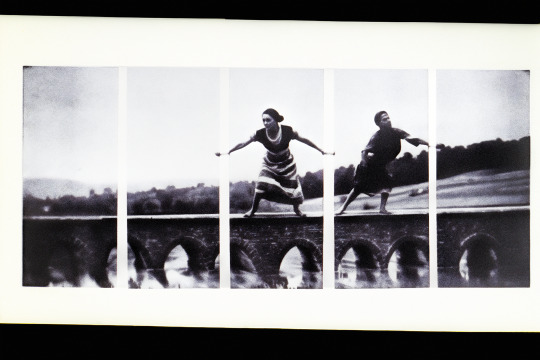
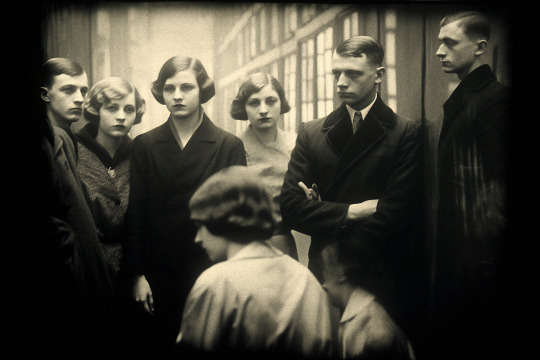






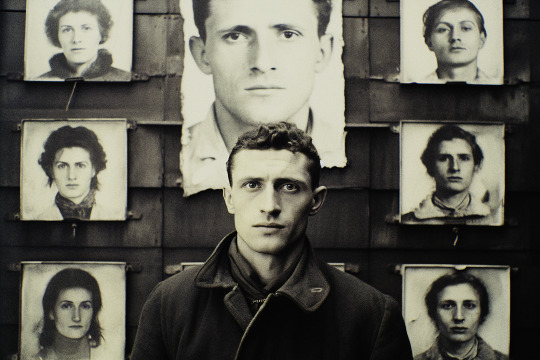

Collective memories IV
#AI#generative#generative art#ai art#Midjourney#neurophotography#promptography#collective memories#vintage style#retro style#diffusion models#neuroart#neurohistory#génératif#art génératif#art IA#mémoires collectives#style vintage#memorias colectivas#estilo vintage#estilo retro#modelos de difusión#inteligencia artificial#生成的#生成艺术#人工智能艺术#集体记忆#复古风格#扩散模型
13 notes
·
View notes
Text
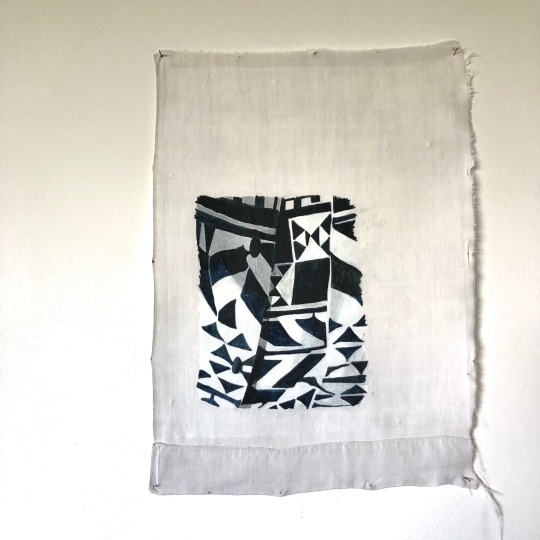
Fragment de « Mémoire cinématographique » La robe de Marianne (Anna Karina, Pierrotlefou) oil painting /papier de soie /drap 48x37cm
#lamenagereenvrac#oilpainting#papierdesoie#collection#fragment#contemporaryart#drap#artists on tumblr#anna karina#pierrot le fou#dress#motifs#mémoire cinématographique
18 notes
·
View notes
Text
Serge Bouchard, un regard sur la Covid
Serge Bouchard, un regard sur la Covid
Un témoignage qui parle, avec une certaine perspective, de cette pandémie, mais surtout un témoignage qui illustre son amour pour la vie. Il est mort dans l’année qui a suivi.
Le 2 juin 2020 dans le cadre du tournage du documentaire “2 mètres”, je suis allée rencontrer Serge Bouchard, anthropologue et philosophe québécois, pour avoir sa vision de ce que nous vivions. Nous en étions au jour 75 du…

View On WordPress
0 notes
Text
Bonjour ! Je fais mon mémoire de master sur la place du français au sein des tags d'Archive of our Own. Afin d'avoir la perspective des utilisateur.ices du site, j'ai créé un petit sondage, et ça m'aiderait grandement si certain.es (ou beaucoup) d'entre vous pouviez y participer.
----
Hello! I'm doing my master's thesis on the French language is used in Archive of our Own's tagging system. I created a survey to collect users' perspectives and I would be very grateful if some (maybe many!) of you could take a few minutes and fill it in.
204 notes
·
View notes
Text

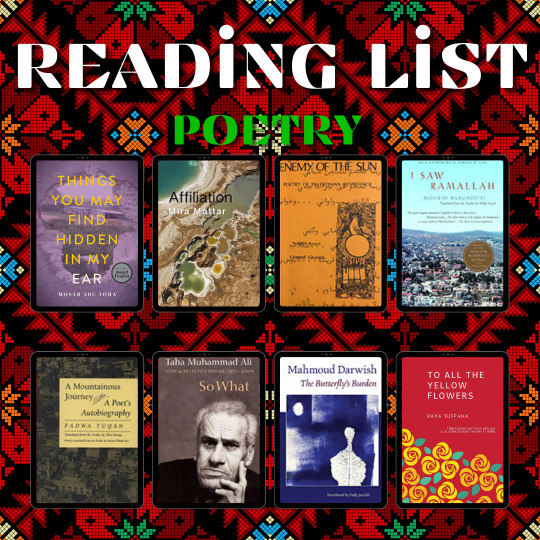






Read Palestine Week
🇵🇸 Good morning, my beautiful bookish bats. Can I start by saying a huge THANK YOU for sharing my Queer Palestinian Book post? Seriously, thank you so much. Let's keep that momentum by observing Read Palestine Week (Nov 29 - Dec 5). I've compiled a list of books to help you, along with a list of upcoming events and resources you can use this week and beyond.
🇵🇸 A collective of over 350 global publishers and individuals issued a public statement expressing solidarity with the Palestinian people. Publishers for Palestine have organized an international #ReadPalestine week, starting today (International Day of Solidarity with the Palestinian People).
🇵🇸 These publishers have made many resources and e-books available for free (with more to come). A few include award-winning fiction and poetry by Palestinian and Palestinian diaspora authors. You'll also find non-fiction books about Palestinian history, politics, arts, culture, and “books about organizing, resistance, and solidarity for a Free Palestine.” You can visit publishersforpalestine.org to download some of the books they have available.
POETRY
🌙 Things You May Find Hidden in My Ear by Mosab Abu Toha
🌙 Affiliation by Mira Mattar
🌙 Enemy of the Sun by Samih al-Qasim
🌙 I Saw Ramallah by Mourid Barghouti
🌙 A Mountainous Journey by Fadwa Tuqan
🌙 So What by Taha Muhammad Ali
🌙 The Butterfly’s Burden by Mahmoud Darwish
🌙 To All the Yellow Flowers by Raya Tuffaha
FICTION
🌙 Gate of the Sun by Elias Khoury
🌙 Speak, Bird, Speak Again: Palestinian Arab Folktales
🌙 Men in the Sun by Ghassan Kanafani
🌙 Morning in Jenin by Susan Abulhawa
🌙 Gaze Writes Back by Young Writers in Gaze
🌙 Palestine +100:Stories from a Century after the Nakba
🌙 Wild Thorns by Sahar Khalifeh
🌙 Out of Time by Samira Azzam
🌙 The Skin and Its Girl by Sarah Cypher
🌙 You Exist Too Much by Zaina Arafat
🌙 A Woman is No Man by Etaf Rum
🌙 Salt Houses by Hala Alyan
🌙 A Map of Home by Randa Jarrar
🌙 Against the Loveless World by Susan Abulhawa
🌙 Minor Detail by Adania Shibli
🌙 The Woman From Tantoura by Radwa Ashour
NON-FICTION
🌙 Blood Brothers by Elias Chacour
🌙 Strangers in the House: Coming of Age in Occupied Palestine by Raja Shehadeh
🌙 Palestinian Art, 1850–2005 by Kamal Boullata
🌙 Palestine by Joe Sacco
🌙 The Hour of Sunlight: One Palestinian’s Journey from Prisoner to Peacemaker by Sami Al Jundi & Jen Marlowe
🌙 Palestine: A Four Thousand Year History by Nur Masalha
🌙 Justice for Some: Law and the Question of Palestine by Noura Erakat
🌙 The Words of My Father: Love and Pain in Palestine by Yousef Khalil Bashir
🌙 Traditional Palestinian Costume: Origins and Evolution by Hanan Karaman Munayyer
🌙 Mountain against the Sea: Essays on Palestinian Society and Culture by Salim Tamari
🌙 This Is Not a Border: Reportage and Reflection from the Palestine Festival of Literature
🌙 We Could Have Been Friends, My Father and I: A Palestinian Memoir, by Raja Shehadeh
🌙 Les échos de la mémoire. Une enfance palestinienne à Jérusalem, by Issa J. Boullata
🌙 A Party For Thaera: Palestinian Women Write Life In Prison
🌙 Light in Gaza: Writings Born of Fire,
🌙 Voices of the Nakba: A Living History of Palestine
#free palestine#save palestine#books#book list#book recs#book recommendation#booklr#book blog#batty about books#battyaboutbooks#arab american heritage month#arab american writers#palestinian writers#palestinian poetry#poetry#poetry books#nonfiction#fiction books#queer fiction#queer community#queer books#muslim writers#read palestine week
208 notes
·
View notes
Text


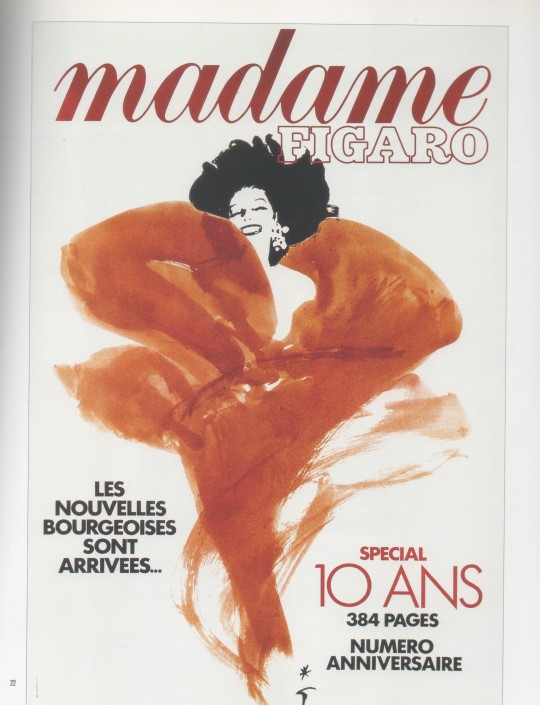









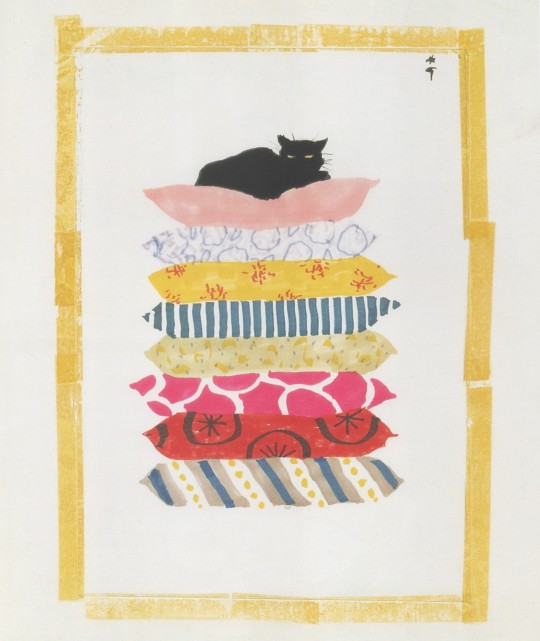
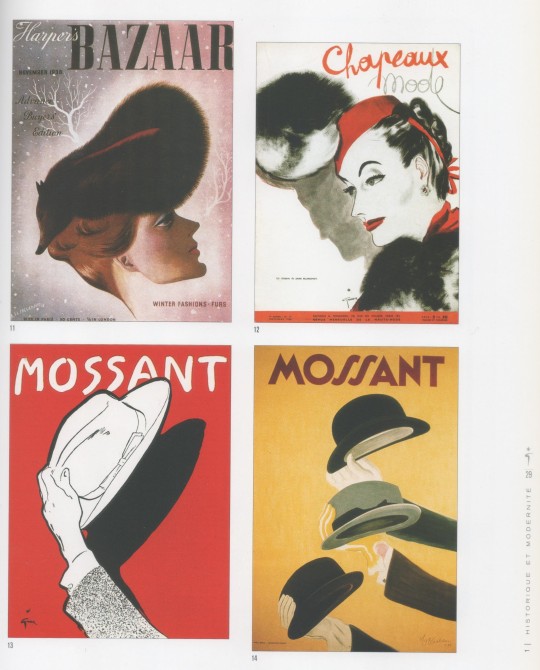
René Gruau L'art de la publicité The Art of Advertising
Réjane Bargiel, Sylvie Nissen
Le Cherche Midi, Paris 1999, 128 pages, 23x28cm, English/French, ISBN 9782862746951
euro 90,00
email if you want to buy [email protected]
Un G surmonté d'une étoile, griffe d'innombrables images appartenant à la mémoire collective. Des lèvres spirituelles qui attendent le baiser, des jambes sublimes jaillissant d'un nuage de plumes, des bras qui se tendent vers vous, des yeux splendidement expressifs qui plongent dans les vôtres. Voilà autant d'images emblématiques et célébrissimes de Gruau, affichiste et illustrateur qui constituent des repères incontournables de l'art publicitaire du XXe siècle. Autodidacte, nourri d'une culture classique et graphique à travers les travaux des grands peintres et illustrateurs du XIXe siècle, il a créé un style. Admirable synthèse graphique, son trait épuré parent de la calligraphie extrême-orientale, le chic de ses femmes mutines, toujours en mouvement symbolisent internationalement l'élégance. Depuis 1947, il imagine la publicité des parfums Dior, réinvente depuis plus de 30 ans l'affiche de music-hall pour le Bal du Moulin Rouge et le Lido. A 90 ans, René Gruau, très actif professionnellement symbolise à la fois l'héritage de l'art graphique et publicitaire du XIXe siècle et la modernité de la fin du XXe siècle. Gruau's trademark, the letter G crowned with a star, bas become a part of our collective memory. It has marked many memorable images: a spiritual set of lips just waiting to be kissed, a sublime pair of legs emerging from a cloud of feathers, arms that stretch out invitingly, splendidly expressive eyes like bottomless pools. Gruau's famous, emblematic images are at the core of twentieth-century advertising art. An autodidact thoroughly familiar with classical painting and graphic art, Gruau drew on the work of the great artists and illustrators of the nineteenth century in order to create his own unique style. In short, his work represents an admirable graphic synthesis. The purity of his line recalls Oriental calligraphy, while his chic, saucy women, always in motion, are an international symbol of elegance. He has been the creative force behind Dior perfume ads since 1947. For over 50 years he has reinvented the dancehall poster for the Moulin Rouge and the Lido. Still a working professional at 90 years old, Gruau symbolizes both the heritage of nineteenth-century modernism.
06/12/23
69 notes
·
View notes
Text
The Many Illustrators of
A Tale of Two Cities
1: Hablot Knight Browne (a.k.a. Phiz)
...& a century-and-a-half-long game of telephone...
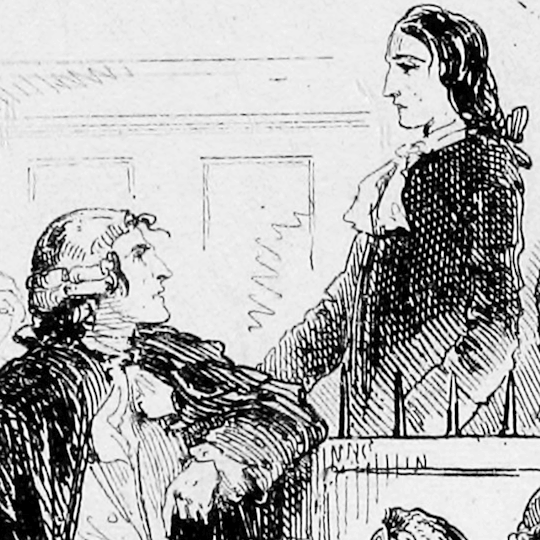
For the first post in a series on the book's illustrators, how could we start with any but the very first one?
"Although a number of critics have pilloried Hablot Knight Browne ('Phiz') for his supposed ineptitude in the program of illustration for A Tale of Two Cities, the fact that he so astutely realized and graphically elaborated so many significant elements of Dickens's letterpress is evidence that his pictorial series reflects an extremely careful reading of the printed text...The visual accompaniment [that these illustrations provided to the novel's monthly installments] was not mere ornamentation, but an aide-mémoire intended to facilitate the monthly reader's keeping track of a discontinuous narrative over a period of seven months."
from "Charles Dickens's "A Tale of Two Cities" (1859) Illustrated: A Critical Reassessment of Hablot Knight Browne's Accompanying Plates" by Philip V. Allingham from the 2003 volume of the journal Dickens Studies Annual.
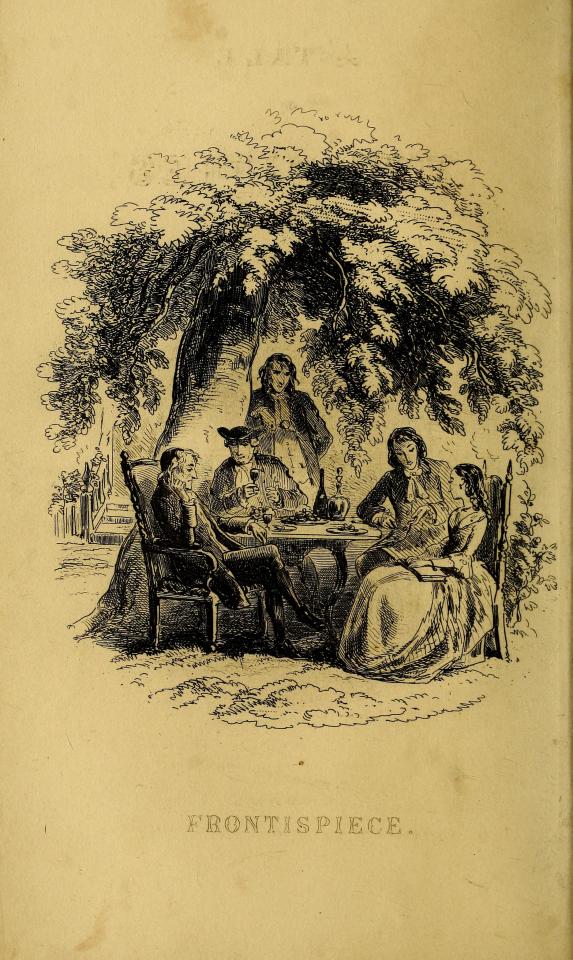
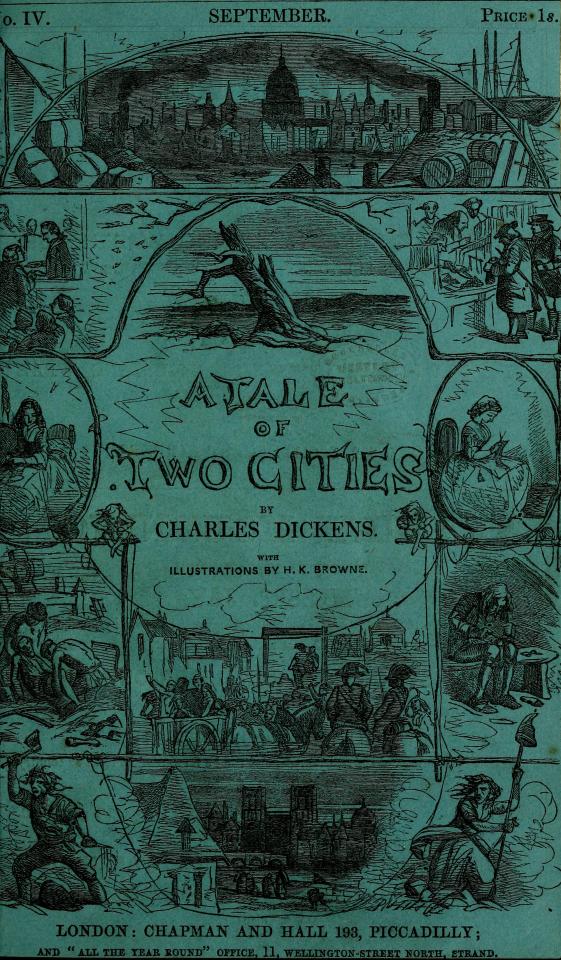
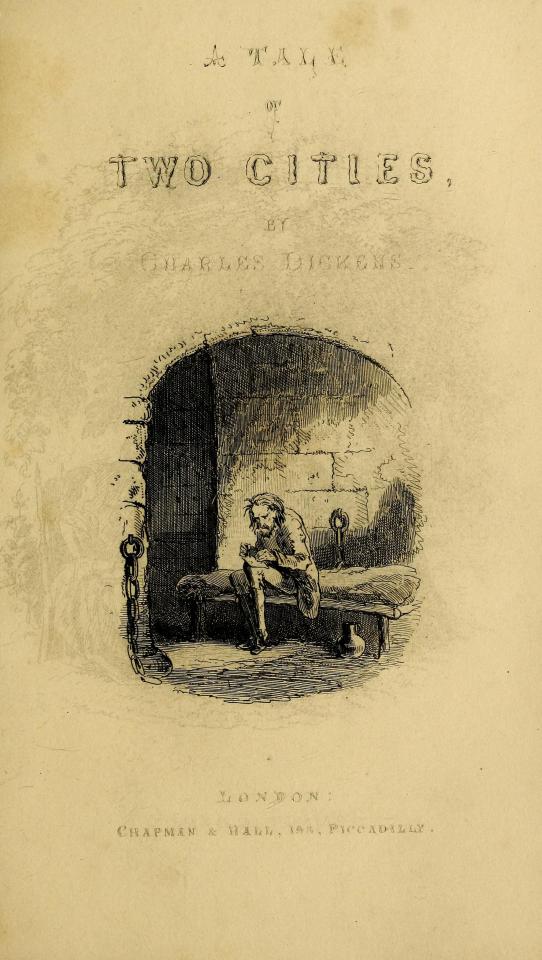
Frontispiece
Cover to the Monthly Installments
Vignette
For some perspective on the significance of this first set of illustrations - published initially within monthly installments of the novel in 1859 (the text of which was collected from the original weekly installments published in All the Year Round, also in 1859) - that single quote comes from an entire article on these illustrations that is itself 49 pages long.
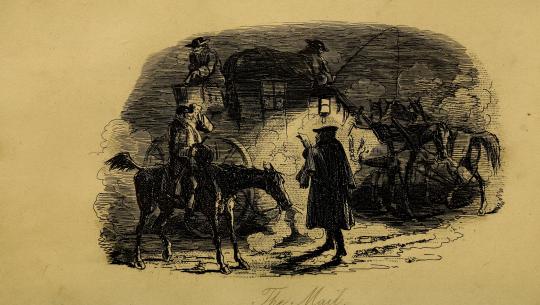
The Mail
As such, suffice it to say that this particular post will not be a thorough examination of the history, context, and impact of these illustrations (though, for those interested, be sure to click on any links you see throughout this post for all sorts of further reading!).

The Shoemaker
Instead, it will simply be a place to observe and appreciate these illustrations for what they are, in their "original" glory.

The Likeness
...I mean, just look at these things! (I'm of course gonna break formality after this one because it's my favorite😌)

Congratulations
In terms of the odyssey of finding the proper edition of these to post, "original" is the operative word.
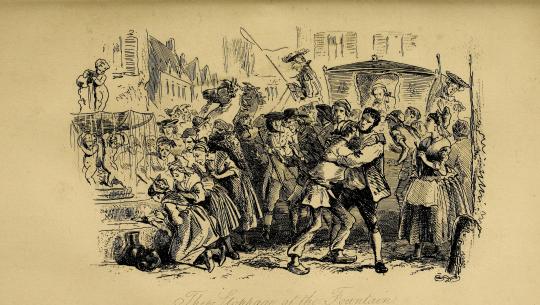
The Stoppage at the Fountain
These are the oldest (except for some or possibly all of McLenan's...more on that many months from now though) and certainly the most iconic of the illustrations of this novel and thus have also had the most mileage, having been passed from edition to edition to edition countless times over the last 164 years.
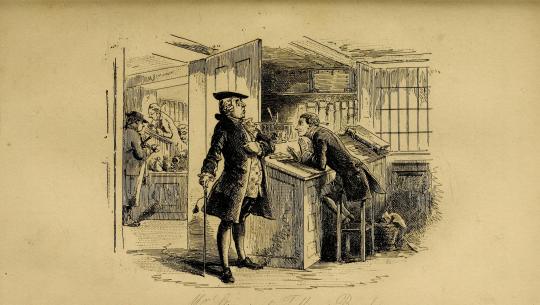
Mr. Stryver at Tellson's Bank
That means - as the gif at the top of this post demonstrates - that these illustrations have slowly been "translated" over time into dozens of distinct images - in ways as innocuous as a change in a shadow and as striking as a change in a character's facial expression.

The Spy's Funeral
These translations have happened in all sorts of ways over the development of printing technology - blemishes, xeroxing errors, low-quality or blurry scans, too much ink being used in printing, image compression, sometimes even actual tracing of the original illustrations! - and as interesting as they can be on their own, for someone determined to find the most accurate representation of Phiz's phenomenal work, they can be...phrustrating.
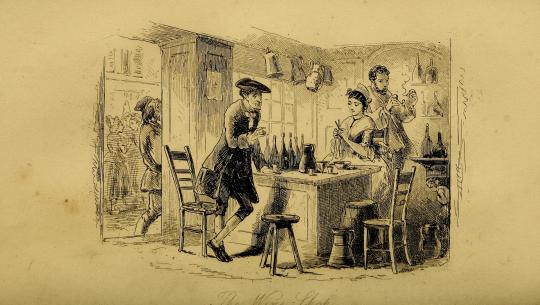
The Wine-shop
In fact, as a sidebar, the illustrations that I used for the Best Character Showdown bracket turned out to themselves be traces and not originals! I am Ashamed and disheartened!
You could even say that I am yet another...
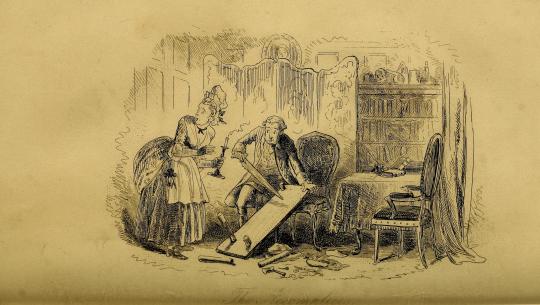
The Accomplices
accomplice in the mistranslation of Phiz's work!
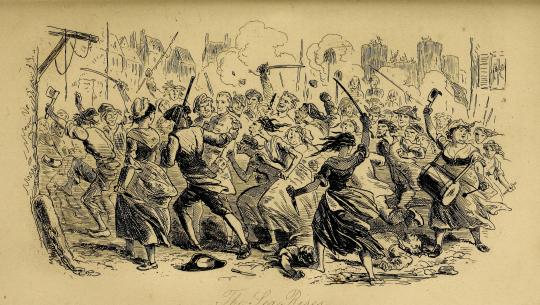
The Sea Rises
Rest assured, though - although they are not from the monthly installments themselves (which as far as my research has gone do not seem to be anywhere on the Internet), these particular scans are sourced directly from an online scan at the Open Library project (contained within the Internet Archive) of the first edition of A Tale of Two Cities, itself also published in 1859.
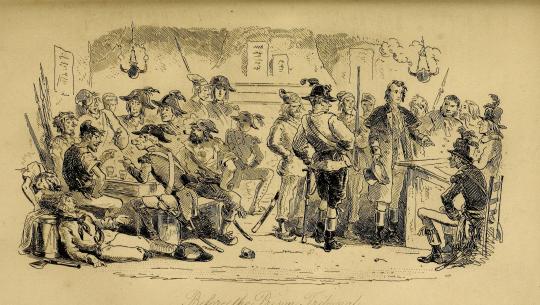
Before the Prison Tribunal
I do wish that they hadn't been cropped the way that they have and that they were available in a (much) higher resolution, but as of now, they're the best representation of Phiz's original work that we netizens have!

The Knock at the Door
A Tale of Two Cities was the final novel that Phiz illustrated for Dickens - and marked the complicated ending to a twenty-three-year (yes) professional partnership between the author and illustrator - but his work here will mark a beautiful beginning to the long archiving project we will experience together here on this blog.
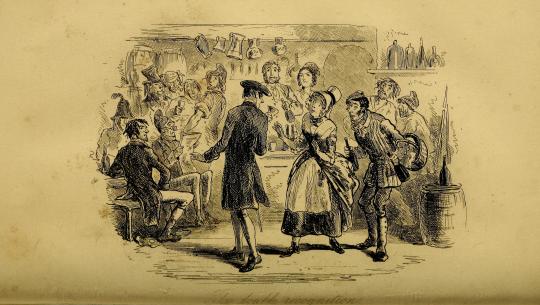
The Double Recognition
Throughout the work of this project, there will be quite a variety of sources being used - from direct scans by me to the two-tone abstractions of PDFs clearly not created for the purpose of storing image information - depending on the needs and availability of each edition.
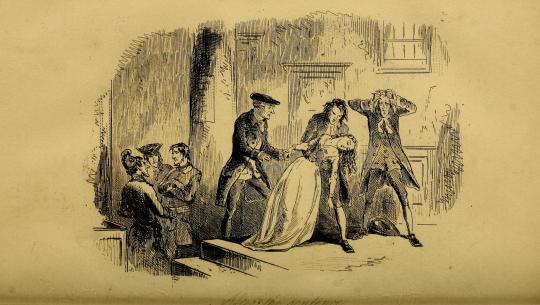
After the Sentence
All of it goes to show the importance of accuracy and attention to detail in archiving art, which is itself an art form to be appreciated.

Hope you've enjoyed!
& the standard endnote for all posts in this series:
This post is intended to act as the start of a forum on the given illustrator, so if anyone has anything to add - requests to see certain drawings in higher definition (since Tumblr compresses images), corrections to factual errors, sources for better-quality versions of the illustrations, further reading, fun facts, any questions, or just general commentary - simply do so on this post, be it in a comment/tags or the replies!💫
#A Tale of Two Cities#AToTC#classic literature#victorian literature#dickens#charles dickens#engraving#illustration#illustrators#Phiz#Hablot Knight Browne#1850s#HOUUGHHHAGHGUHGGHHHHOUHGHHOUHGHHGAHGHSGHGHGH#how long have i been working on this today? has it been eight hours?#well? how did I get here?#again most of them won't even remotely be like this#but it's phiz! i gotta do phiz right!#also for the record: for the first gif I made all eight variations grayscale and modified their contrast#and for the second gif I sepia-toned and modified the contrast of one of the illustrations#all for the sake of readability and reducing flashing!
26 notes
·
View notes
Note
The Pétion playing with the dog anecdote is so sweet. Could you do a pet compilation? I know there’s Brount and that Couthon had a dog (and a bunny?), but that’s all I’m aware of.
That’s a great idea!
Is the puppy (petit chien) you are raising for my sister as pretty as the model you showed me when I passed through Bélhune? Whatever it is, we will always welcome it with distinction and pleasure. We can even say that, however ugly it may be, it will always be lovely.
Robespierre to ”a young girl” in a letter dated June 6 1788
[Robespierre] had a dog, named Brount, that he loved a lot; the poor animal was very attached to him.
Le Conventionnel Le Bas: d’après des documents inédits et les mémoires de sa veuve (1901) page 107
At Madame de Kéralio’s I have seen [Robespierre] hold himself apart for an hour, playing with a big dog.
Anecdote reported in 1791 by Charles-Engelbert Oelsner, cited in Robespierre: a revolutionary life (2010) by Peter McPhee, page 94.
On these occasions [Robespierre] was always accompanied by a large dog , of the Pyrenean breed, of which he was very fond. Strange to say, several of these monstrous anomalies of the Reign of Terror, were most partial to animals; and the ferocious Couthon would shed tears when his favourite spaniel was ill. Robespierre's dog always kept watch at the door of his master's bed-chamber. […] [Robespierre] appeared to me like a bird of prey — a vulture; his forehead and temples were low, and flattened; his eyes were of a fawn colour, and most disagreeable to look at; his dress was careful, and I recollect that he wore a frill and ruffles, that seemed to me of valuable lace. There were flowers in various parts of the room, and several cages, with singing birds, were hanging on the walls and near the window, opening on a small garden.
Recollections of Republican France 1790 to 1801 by John Gideon Millingen, page 283-284 and 288.
[Maximilien] rarely shared the games and pleasures of his comrades; he liked to be alone to think at his ease, and passed entire hours reflecting. He had been given pigeons and sparrows which he took the greatest care of, and close to which he often came to pass the moments which he did not consecrate to his studies. […] We were sent, my sister and I, to go join our two brothers every Sunday. These were days of happiness and joy for us. My brother Maximilien, who collected images and engravings, displayed his riches and was happy with the pleasure of seeing that we felt they should be contemplated. He also gave us the honors of his aviary, and placed his sparrows and pigeons, one after another, into our hands. We strongly desired that he should give us one of his favorite birds; we solicited this with entreaties; he refused for a long time, fearing that we would not take the best possible care of them. Yet one day, he ceded to our insistences, and gave us a pretty pigeon. My sister and I, we were enchanted. He made us promise to never let it lack for anything; we swore thus a thousand times, and kept our word for a few days, and moreover we would have kept our oath forever if the unhappy pigeon, forgotten by us in the garden, had not perished on a stormy night. At the news of this death, Maximilien’s tears flowed, he piled reproaches on us that we had only too well merited, and swore that he would no more confer any of his dear pigeons on us. It was sixty years ago that by a childish flightiness I was the cause of my elder brother’s chagrin and tears: and well! My heart bleeds for it still; it seems to me that I have not aged a day since the tragic end of the poor pigeon was so sensitive to Maximilien, such that I was affected by it myself.
Mémoires de Charlotte Robespierre sur ses deux frères (1833) page 47-49
Talking of so important a subject, shall I be pardoned, Mademoiselle, if I speak to you of canaries? No doubt I shall be if the canaries are interesting; and how could they not, considering they come from you? They are very pretty, and, being bred by you, we expected them to be the most gentle and sociable of canaries. What was our surprise when, upon approaching the cage, they threw themselves against the bars with an impetus which made us fear for their lives! They recommence this performance every time they see the hand that feeds them. What plan of education did you adopt for them, and how have they acquired this savage character? Do the doves that the Graces rear for the chariot of Venus display this wild temperament? Such a face as yours should surely have familiarized without difficulty your canaries with the human face. Or is it that, after seeing yours, they cannot tolerate any other? I beg of you to explain this phenomenon. Meanwhile, with all their faults, we shall always find them lovable. My sister begs me to express her thanks for your kindness in sending her this present, and to assure you of the affection with which you have inspired her.
Robespierre to mademoiselle Duhay in a letter dated June 22 1782
He detests violent entertainments, and when M. Deshorties spoke to him this very evening in front of me of going on a hunt, M. de Robespierre, only responding by a refusal of his head, gently moved away the firearms that were shown to him. This gesture was imbued with a kind of repugnance. I even saw a kind of tear glint and a bitter smile form on his lips when we talked about the prey that we would infallibly bring back. He is seen as the greatest lover of the pigeons with which he coos. […] I have taken detailed notes on all this from one of his friends, with whom he is lodging on rue de Saintonge. This friend, like M. de Robespierre, is a great lover of birds; they have raised several hundred birds in a fine aviary; these gentlemen are skilled bird-keepers even if they are not deputies of the first rank.
Mémoires tirés des archives de la police de Paris: pour servir à l’historie de la morale et la police(1838) by J. Peuchet, volume 5, page 340-342. The historian Hector Fleischmann questioned the authenticity of this report, given the fact he could see few reasons for police to investigate Robespierre back in 1789-1790.
I was able to converse between 1838 and 1839 with a famous parrot who had been the friend of Robespierre. He belonged to Mme the widow Lebas...whom I had the honour of seeing often in her little house in Fontenay-aux-Roses, where she would make the sign of the cross when she pronounced the name Robespierre... As to her parrot, when one said "Robespierre", it replied Hats off! Hats off! (Chapeau bas! chapeau bas!) It sang the Marseillaise with perfect diction and Ça ira like a Jacobin. It was - and perhaps, thanks to its diet of grain, still is - a parrot sans-culotte, the like of which can no longer to be found. Mme Lebas recounted with great emotion how she had managed to save this precious psittacus after Thermidor. It had been seriously compromised. After the arrest of Robespierre and Lebas, in the course of a long domiciliary inspection, every time the name of Robespierre was pronouned the parrot would repeat its refrain, Hats off! Hats off! The government agents had grown impatient and were about to wring its neck, when Mme Lebas, as quick as lightning, grabbed the bird, opened the window and set it free. The poor parrot flew from window to window, until it found a charitable person to open up for it; a few days later Madame Lebas was able to regain possession of this last friend left to her by Robespierre, the only one perhaps, besides his elderly mistress, who has remained faithful to his memory.
L’Union médicale: journal des intérêts scientifiques et pratiques, moraux et professionnels du corps médical (1861) volume 12, page 258-259. This anecdote is a bit suspect, because how would Élisabeth be able to go and fetch the parrot ”a few days” after the arrest of Robespierre when she herself was arrested just three days after it?
My husband had a dog named Schillichem, of a German breed; he only returned three days after the death of his master; he was panting, his tongue hanging out; that poor beast had passed that time on his master's grave.
Le conventionnel Le Bas: d’après des documents inédits et mémoires de sa veuve (1901) page 145
Embrace Henriette for me. Schillickem (sic) caresses me a lot and I hug him back.
Letter from Philippe to Élisabeth Lebas, May 16 1794
[Couthon] wore a white dressing-gown, and on his arm was a young bunny which he was feeding with clover. His son, an angelically beautiful boy of three or four, alternately stroked his father's hand and the pretty white animal. These innocent sourroundings and Couthon's great affability charmed me. […] Persuaded that Couthon was sincere I said to him: ”Monsieur Couthon, you who are all-powerful on the Committee of Public Safety, are you aware that the Revolutionary Tribunal daily condemns unfortunate men who are accused of the same crime as these magistrates? This very day, Monsieur Couthon, sixty-three prisoners are to be executed under this pretext.” This reflection produced an indescribable effect on Couthon: his face became distorted and assumed a tiger-like expression... He made a movement. The bunny was overturned and the child, weeping, rushed into his mother's arms.
Extract from the memoirs of Maurice André Gaillard, cited in Romances of the French Revolution (1909) by G. Lenotre, volume 1, page 171-172
During the Constituent Assembly, at the time of the revision, I was one day with Buzot's wife, when her husband returned from the Assembly very late, bringing Pétion to dinner. It was the time when the court had them treated as factious, and painted them as intriguers, all occupied in stirring up and agitating. After the meal, Pétion, seated on a large ottoman, began to play with a young hunting dog with the abandonment of a child; they both let go and fell asleep together, snuggled on top of each other: four people conversing did not prevent Pétion from snoring. ”So here we have this rebel,” said Buzot, laughing; ”we were looked askance on leaving the room, and those who accuse us, very agitated for their party, imagine that we are to maneuver!”
Mémoires de Madame Roland, volume 2, page 167
I had crossed the yard and was going to my carriage while finishing a conversation with an old sans-culotte, certainly well paid to indoctrinate the dupes. A cute dog pressed itself against my legs. “Is this poor animal yours? said my coachman to me, with an accent of sensibility very rare in his equals, and which struck me singularly. "No, I don't know it," I replied gravely, as if it were a person, and already thinking of something else entirely: ”Drop me off at the galleries of the Louvre.” I wanted to see a friend there to talk about the means of getting Roland out of Paris. But we had only gone twenty foot when the carriage stopped. "What is it?” I said to the coachman. ”Well! he left me like a fool, while I wanted to keep him for my little boy, who would have fun with it: Petit! Petit! come here!” I remembered the dog; I found it sweet and agreeable to have a good man, a sensible father, as my coachman at this hour. “Try to catch it, I shouted to him, put it in the carriage and I will guard it for you.” The good man, very happy, takes the dog, opens the door and gives me company. This poor animal seemed to feel that she was finding protection and asylum; I was well caressed, and I remembered this tale by Saadi, which depicts an old man, the last of men, repulsed by their passions, retired to a forest where he had made a dwelling. He animated his stay with a few animals which paid for his care with the affectionate testimonies of a gratitude to which he had confined himself, failing to find so much in his fellows.
Mémoires de Madame Roland, volume 2, page 81-82
Fréron often visited madame Duplessis country house at Bourg-la-Reine and every time he played with the bunnies there. Hence the nickname Bunny (Lapin) that was given to him by Lucile.
Footnote in Correspondance inédite de Camille Desmoulins (1836) by Marcellin Matton. Matton was a friend of Lucile’s mother and sister, and it’s probably from them he acquired this anecdote.
Monsieur Duplessis, his cabinet, the fireplace,
My sister and I know you must go to the countryside one day this week. Do you remember that you for more than fifteen days have promised to bring you with us there? You told me, that if I learned Zaire, you would give me whatever I wanted. I already know it almost by heart, papa, and I’m dying to see the little piglets. My sister joins me to ask of you this same favor, and to present you the respectable attachment with which we are, my dear papa, your very humble servants.
Lucile and Adèle.
Undated note from child Lucile Desmoulins, probably written sometime in the 1780’s.
We have gotten ducks, I went to see them. […] I ate gooseberries, and then I was alone in the pavilion, I picked a little hornbeam which I brought to Lolotte, then I I was dreaming in the grove.
Lucile Desmoulins’ diary, June 28 1788
After dinner I went for a walk in the grove. I had fun breaking dead wood, then I found a snail. I examined it a little, I broke its shell, but having fallen onto my stomach it made me cry out loud, because this ugly beast was crawling on my stomach! I made a big hole and buried it. In two or three days I will go and see what has become of it.
Lucile’s diary, June 30 1788
An hour after leaving you yesterday, citoyenne amie, I gave Horace his snake (couleuvre), which he saw again with tenderness, and they played together to fully reconnect.
Letter from Panis to Annette Duplessis regarding Horace Desmoulins, dated March 1 1802. If anyone has a more logical translation, alternatively knows if snakes were optional pets in the 19th century, feel free to share!
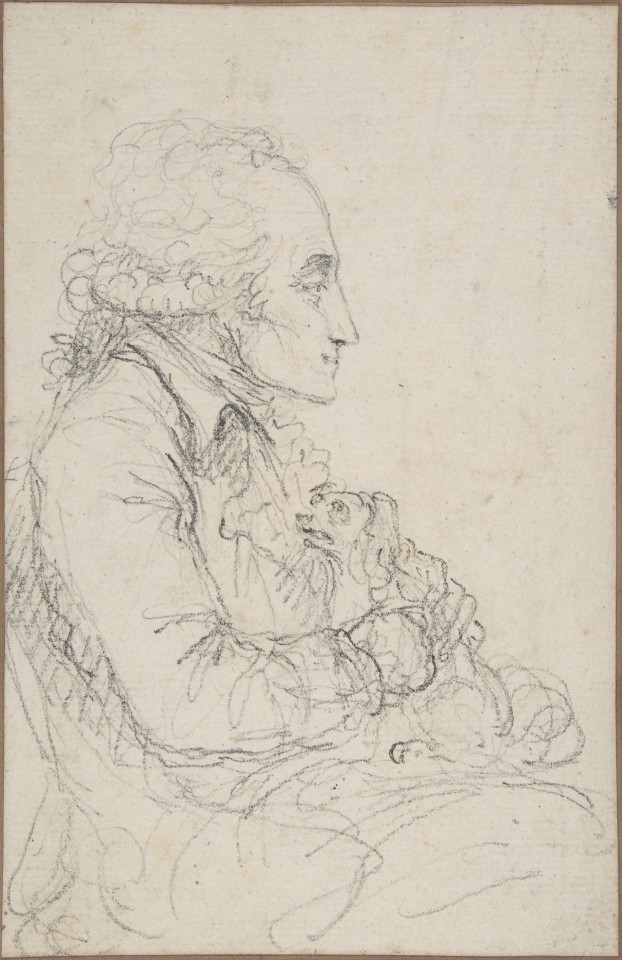
Georges Couthon at the Convention with a small dog, sketch by Dominique Vivant Denon from 1793.

Robespierre with a small dog, painting by Louis-Léopold Boilly from 1783.
#if all these reports are authentic then robespierre’s bird psychosis was worse than I first thought…#robespierre#maximilien robespierre#georges couthon#lucile desmoulins#horace desmoulins#stanislas fréron#i want couthon and fréron to start a bunny farm together just to see what happens…#ask#frev compilation#manon roland#philippe lebas
66 notes
·
View notes
Text


Two letters signed "Docteur Marat".
The first one, dated January 24, 1788, possibly refers to the Mémoires academiques. It was published by ML. Noël Charavay in the January 1st issue of La Chronique médicale, 1904 (p. 27):
"Madame,
Nothing is foreign to a mind as cultured as yours: deign to receive the homage of my book, sacrifice a few moments to its reading, and proselytize the truth. I respectfully remain, Madame, your most humble and obedient servant.
Dr. Marat.
Paris, January 24th 1788."
The second letter, addressed to M. Méquignon and dated February 28, 1792, may have been the last letter in which Marat signed only "Docteur Marat". It was also communicated by Charavay. You can find it on pp. 223-224 of Marat's correspondence, collected by Charles Vellay:
"To Monsieur Méquignon l'ainé, rue des Cordeliers.
My compliments to Mr. Méquignon
It [has] been nearly three years since I settled an account with him. On the books I have given him to sell on my behalf, in return for the agreed discount, I ask him to kindly give Mr Feveaux, the bearer of this bill, the bill and the amount of the articles sold, as well as the acknowledgement of the articles that remain unsold. The bearer is authorized to give receipt in my name. This bill will serve as a guarantee.
Le Dr. Marat.
Paris, february 28th, 1792."
#le docteur marat#translations may be subject to errors!#marat#marat's correspondance#letters#jean paul marat#my posts
37 notes
·
View notes
Text

Sous France : Mémoire d'un quartier populaire
Mon cheminement photographique a débuté par des captures du quotidien dans un quartier populaire de France, celui de mon enfance, la Plaine d'Ozon : des scènes de vie, des sourires d'habitants, des enfants qui jouent, des bâtiments témoins d'une époque révolue. Chaque cliché est imprégné de souvenirs, teinté de nostalgie.
Depuis les années 90, j'ai évolué dans le milieu associatif et l'éducation populaire, aux côtés de militants engagés contre le racisme et l'extrémisme.
La photographie est ainsi devenue mon vecteur d'engagement, un moyen d'exprimer mon adhésion à ces combats.
C'est à travers ma passion pour la photographie que j'ai trouvé une voix, une manière d'exprimer souvent l'inexprimable.
Je n'ai jamais cherché à être un porte-parole, mais simplement à donner voix à mes convictions à travers mes images.
Parfois, ma démarche a été mal comprise …
Néanmoins, l'une de mes plus grandes fiertés reste la présence d'une de mes photos dans un manuel scolaire d'histoire géographie d'un collège. C'est très honorifique de savoir que cette photo permet de sensibiliser des collégiens à la lutte contre le racisme.
Au cœur de mon travail, je mets aussi en lumière une jeunesse vibrante, multiculturelle, invitant chacun à s'élever, à respecter autrui, à valoriser ses talents.
Après plus de 15 ans derrière l'objectif, je réalise que je suis devenu le témoin d'une histoire, celle d'un quartier en mouvement, en évolution.
Ma passion demeure intacte, et j'espère continuer à contribuer à la mémoire collective de mon quartier, à sensibiliser, à inciter à l'action.
Chaque image est une pierre apportée à l'édifice d'une société plus juste, plus inclusive.
📷 𝑀𝐾 | ©
☞ 𝑺𝒐𝒖𝒔-𝑭𝒓𝒂𝒏𝒄𝒆
10 notes
·
View notes
Note
I wish you a lot of fluff ! Sorry for the weird asks.
So, from what I gather from the dynamic of the Sanson family.
So, basically:
Charles Sanson II married his step-aunt Anne-Marthe and the two had three kids: Anne-Renée, Charles-Jean-Baptiste and Nicolas-Charles-Gabriel. After his death, his wife remarried in 1732 to Jean-Baptiste Barré, who was her husband's assistant/replacement and later became a torturer. We don't know what happened exactly with these two, but Anne-Marthe was eventually forced to flee him (or her son, or their never ending fights) in 1745 and she decided to live with her in-laws.
By that time, Jean-Baptiste had the time to marry twice and have a bunch of kids as head executioner. Because patriarchy and patrilocality, it implies that he made his wife and kids live in with a potencial rival (his step-father) while also having apprentices.
So, either Sanson III sided with his step-father (unlikely, given how torturer groups work, and the "tous parents, tous rivaux" dynamic of dynastic executioners) against his mother or becoming an executioner at age 7 fried his brain to the point he thought it was a good idea to make his wife move in with a man who was either an abuser or a rival, and have empregnate her several times within that cohabitation. The most generous explanation would be that he believed it would be good if his children grew up with a swifthanded older man in their lives.
Whatever the case was (Jean-Baptiste either being a monster who turned against his own mother in a very cowardly way or severely mentally disturbed), it doesn't bode for a healthy dynamic. However, the fact Barré is never mentioned in the Mémoires is quite telling, since it indicates Charles-Henri either didn't want to talk about him to his wife, his children nor grandchildren or those that collected the Mémoires found him incredibly unsympathetic to the point they chose to ignore his existance. I think that tells a lot, that and the fact his wife had to flee him, does not bode well for the kind of person Barré was, not to mention what we know now about the psychological effects of being a torturer.
There is that part of the Mémoires, in which a rumor accuses Charles-Jean-Baptiste of killing his eldest son because said son stole a large sum of money, but it turns out false and said son is innocently playing in the garden.
Keeping up with kardashians: goth version
8 notes
·
View notes
Text

Collective memories VI, 8
Follow me, — says Visual Ratatosk
#AI#generative#generative art#ai art#Midjourney#neurophotography#promptography#collective memories#vintage style#retro style#diffusion models#neuroart#neurohistory#génératif#art génératif#art IA#mémoires collectives#style vintage#style rétro#modèles de diffusion#intelligence artificielle#generativ#generative Kunst#KI-Kunst#kollektive Erinnerungen#Vintage-Stil#Retro-Stil#Diffusionsmodelle#künstliche Intelligenz#generativo
10 notes
·
View notes
Text
Congééééé du coup je lis je joue à acnh je lis je mange je dors je regarde Netflix je lis je vais me balader avec l'ado ou avec son père, je joue à acnh (beaucoup ohlala), je lis encore, je dors un peu devant le tour de France ou la F1 et voilà voilà le programme du bonheur et du coup comme je voulais acheter des BD à mes patients pour la fin de l'année scolaire, je me suis dit que c'était l'occasion de commencer une nouvelle série de manga parce que justement j'ai pleeeiiin de place dans la bibliothèque (c'est faux) et j'ai opté pour Arbos anima. C'est en 5 tomes, ils sont édités par Glénat pour la VF depuis 2016 et là ça n'a pas l'air ni d'être terminé ni de continuer donc peut-être que la fin du tome 5 me laissera dans un état de frustration insupportable mais en attendant c'est une chouette lecture.
On est dans un seinen assez sympa qui m'a attirée avec sa couverture, puis le résumé m'a plu parce qu'il est question de botanique. Un jeune garçon, Noah, possède le don de lire la mémoire des plantes, ce don est vécu comme une malédiction par sa famille, qui l'enferme pendant 15 ans dans la serre. Sympa sympa.
Il devient "collecteur botaniste", il reçoit des missions pour lesquelles il doit chercher et collecter des plantes rares. Au fil des chapitres du premier tome, on fait la connaissance du personnage central ainsi que de ses deux acolytes : un ancien pirate qui lui sert de garde du corps, et une jeune fille qui souhaite venger sa forêt, brûlée il y a longtemps par un autre collecteur. D'ailleurs elle déteste les collecteurs parce qu'elle les prend pour des pilleurs et c'est un peu ça, mais Noah c'est pas pareil, il aime les plantes, il les traite bien, et il veille à en laisser dans leur milieu naturel.
Le tome 2 voit l'arrivée de l'ennemi principal, qui est justement le type qui a brûlé la forêt, c'est fou les hasards de la vie hein, sauf qu'il s'en fout de cette forêt, pour lui c'est de l'histoire ancienne, il veut juste tout savoir sur le don de Noah parce qu'il est un tantinet jaloux. Et manifestement, il est plutôt belliqueux.
Ça me fait seulement 9 livres depuis le début de l'année, les examens ont fait baisser les stats et celui-ci et les autres sont résumés dans le billet épinglé

20 notes
·
View notes
Note
What would you say it’s the biggest misconception about French revolution?
The idea that the French Revolution changed nothing. That it was pointless. That everything reverted back to what it was.
It's a lie.
More than a lie, it's propaganda.
Louis XVIII and Charles X tried to go back, but they couldn't. The latter faced another revolution when he tried too hard. Over 30 years had gone by since 1789. 30 years is a generation. The fight would go on throughout the 19th century. Arguably, we're still fighting their fight. We're still trying to change the world to a freer, more equitable, more inclusive and supportive world. Liberté, Égalité, Fraternité.
There's always one anecdote I think of:
"Meanwhile, during the French Revolutionary Wars the French Army stopped floggings altogether. The King's German Legion (KGL), which were German units in British pay, did not flog. In one case, a British soldier on detached duty with the KGL was sentenced to be flogged, but the German commander refused to carry out the punishment. When the British 73rd Foot flogged a man in occupied France in 1814, disgusted French citizens protested against it."
Source: Rothenberg, Gunther E (1980). The Art of Warfare in the Age of Napoleon, p. 179.
Now, yes, I'm quoting this from Wikipedia but I did research it. They did discuss these things. Specifically, Camille Desmoulins talks about how vile it is that other armies do that.
So, yes, their thoughts had an impact, and shaped and changed the world.
Their ideas survived. Their speeches were collected, preserved, reprinted - Robespierre, Saint-Just, Marat, Babeuf. Their memory became a symbol. They went on to change the world.
This quote by Chateaubriand while reactionary in nature still illustrates it best in my opinion:
« Passe maintenant, lecteur ; franchis le fleuve de sang qui sépare à jamais le vieux monde dont tu sors, du monde nouveau à l'entrée duquel tu mourras. »
– Mémoires d'outre-tombe, Livre 5, Chapitre 7 – octobre 1821
[Pass on, now, Reader; cross the river of blood which separates forever the old world, which you are leaving, from the new world on whose threshold you will die.]
The world was changed forever.
70 notes
·
View notes
Note
Salut!
j'ai vu que tu faisais une thèse sur les tags en français sur AO3; ça m'intéresserait de savoir comment ça avance (considère que je demande à m'inscrire à la mailinglist hypothétique Thèse AO3 Français).
Hola! Je vais essayer de donner des nouvelles au fur et à mesure de l'avancement de ce mémoire, puisque j'ai été agréablement surprise de l'enthousiasme des gens pour mon petit sondage ;)
Juqu'ici j'avais surtout réalisé le travail préparatoire : lire la recherche antérieure, faire l'état de l'art, établir une question de recherche et commencer à collecter des données. Si ça intéresse des gens, je pourrais partager des liens d'articles académiques que j'ai trouvé intéressants (la majeure partie sont en anglais parce que c'est dans cette langue que les Fan Studies se sont le plus développées, mais il y a aussi de la recherche en français).
J'essayerai de vous faire un petit post une fois que j'aurais fini d'analyser els résultats du sondage pour que vous puissiez voir à quoi vous avez toustes contribué ! Pour le reste, on verra si j'ai le temps de tout vous détailler, mais dans le pire des cas, j'essayerai de rendre le mémoire disponible quelque part où les gens pourront le trouver.
12 notes
·
View notes
Text
tagged by the delightful @meadowsidevalley :3
currently listening: to rufus wainwright's 2005 album want
currently watching: shamefully, what we do in the shadows. proudly and with my whole chest, riverdale.
currently reading: finished les mémoires d'hadrien by marguerite yourcenar and started a collection of auden's poetry yesterday. predictably, neither of these are on any of my lengthy reading lists.
current obsession: yours sounds so very wonderful! mine is more mundane: banker's lamps. look at these beauties. and also two non-banker's lamps because look at them. bottom left is on a little swing ...
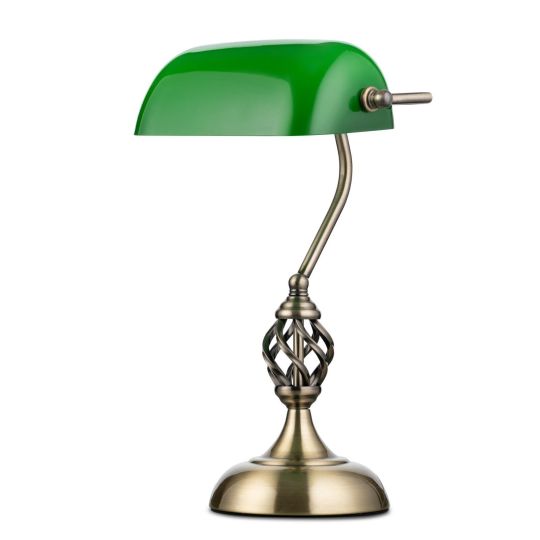
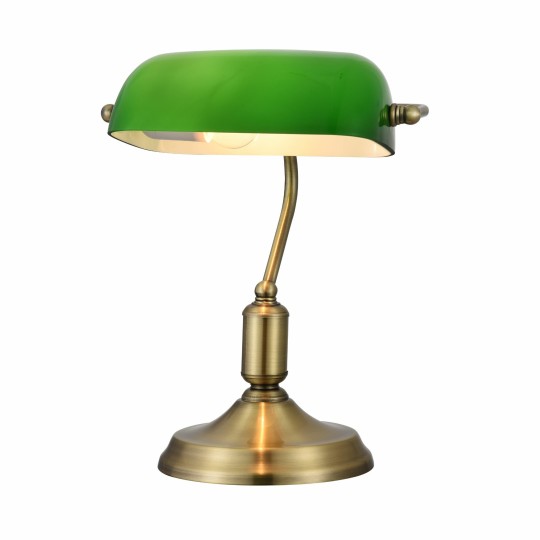




tagging @ursulakleguin @ladyoftheharbour @vampireweekend2008 @kendallroyvevo have a lovely day 🪐
14 notes
·
View notes